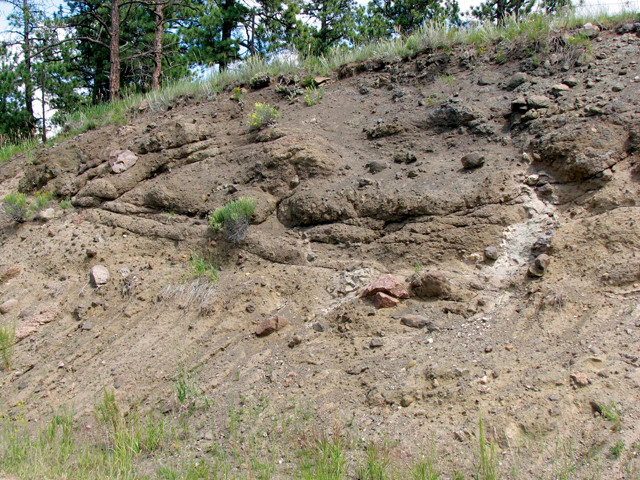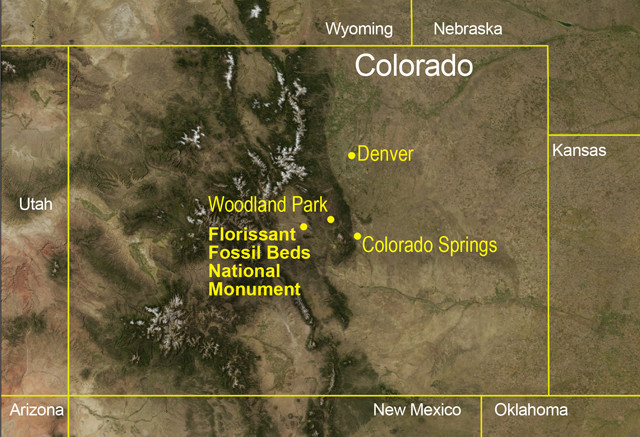
by Terri Cook and Lon Abbott Thursday, June 7, 2018
Beneath the grassy meadows and pine-studded hills of central Colorado lies one of the richest and most diverse fossil deposits in the world. From enormous petrified redwood stumps to the individual lenses in a fly’s compound eye, an entire ecosystem of rarely preserved life forms has been fortuitously fossilized, narrating the story of a warmer and wetter prehistoric Colorado that thrived at the brink of a dramatic episode of global cooling.
In the Late Eocene 34 million years ago, a lush forest carpeted the Florissant Valley, where redwood trees grew alongside hardwoods, palms and ferns. Just 25 kilometers to the southwest, the towering Guffey volcano, part of a large volcanic field, loomed above the land. Streams of ash periodically flowed from the mountain, and occasionally its flanks collapsed, sending roiling lahars — torrents of mud and debris — roaring down the valley at speeds approaching 160 kilometers per hour. One lahar dammed an ancient creek, forming long, narrow Lake Florissant and setting in motion a chain of events destined to fossilize the more than 1,700 species of flora and fauna now protected by Florissant Fossil Beds National Monument.

A hillside of mud and debris is all that remains of the lahar that dammed ancient Lake Florissant. Credit: Terri Cook and Lon Abbott
Situated about 55 kilometers west of Colorado Springs, the fossil beds are easily visited on a day trip. It’s best to begin with the gentle, nearly 2-kilometer-long Petrified Forest Trail. As soon as you head out the back door of the visitor’s center, you’ll experience the monument’s most stunning attraction: a stand of huge fossilized tree stumps, rooted in the exact spots where they once grew. Spectacular examples lie under covered enclosures along the wheelchair-accessible trail’s first 90 meters. These include a 4-meter-wide stone stump, which, like most in the park, once supported an ancient redwood tree similar to California’s coastal giants. Next to the isolated stump stands the world’s only known trio of fossilized redwoods, formed when sprouts grew up around their parent.
The trail passes more stumps, including “Big Stump,” whose nearly 12-meter circumference supported a 500- to 1,000-year-old tree that towered 60 meters above the forest floor — until a Guffey volcano lahar buried the forest under 5 meters of mud. The trees’ exposed portions eventually rotted away, but the mud shielded the entombed sections from decay. Groundwater slowly seeping through the lahar dissolved shards of silica glass. The silica-rich water then percolated through the buried stumps; the trees’ organic content altered the local chemical environment, allowing silica to precipitate. This process occurred so slowly that each silica crystal grew to fill a single tree cell, painstakingly turning the stumps — some as tall as 5 meters — into stone.
About 30 meters beyond the Redwood Trio the trail forks. Take the Ponderosa Loop on your left. Behind a split-rail fence is a low outcrop of gray mudstone whose thinly bedded layers accumulated in the quiet waters of ancient Lake Florissant. Known as “paper shale,” each “sheet” is actually a couplet, with a thin clay layer from altered volcanic ash bonded to a layer of diatoms, single-celled plankton housed in protective silica shells.
Lake Florissant’s water chemistry supported vigorous plankton blooms consisting of billions of diatoms. One hypothesis to explain the incredible diversity of Florissant fossils is that the diatoms secreted a film of sticky mucus that immediately embalmed leaves, insects and spiders blown or washed into the lake. This mucus sealed off the precious cargo from the corrosive effects of oxygen, and then the organisms sank to the lake bottom. The slow rain of sediment eventually compressed the fossils, clay and diatom shells into these paper shales. Erosion of the landscape over the last 5 million to 10 million years slowly unearthed the shales and the organisms entombed within them.
To examine Florissant’s exquisite fossils in more detail, return to the visitor’s center. Florissant’s collection of insects is world class; more than 50,000 specimens from the fossil beds are kept at museums around the world. Flying ants and beetles are especially abundant and diverse, but the lakebeds also host flies, spiders, moths, butterflies, millipedes and the first fossil tsetse fly ever found. Vertebrate fossils are comparatively rare, but include fish like catfish, pirate perch, suckers and bowfin. The skies above the lake were home to birds including the cuckoo and the roller. Paleontologists have even found a small opossum unfortunate enough to fall into the lake. You can find more fossils on the park’s website, www.nps.gov/archive/flfo/online_museum./index.html, where you can view some of Florissant’s 11 species of conifer trees and more than 100 species of hardwoods, including members of the elm, willow, beech, rose and walnut families.

Credit: AGI/NASA
The mixture of plants and insects that thrived along Lake Florissant’s shores does not resemble any modern assemblage. Some of Florissant’s fossil species are closely related to species that today live in the subtropics of Asia, Africa or Mexico. Others were adapted to cooler climates. Through a combination of techniques, including identifying each plant fossil’s nearest living relative and studying leaf shapes, researchers have concluded that Florissant was much warmer 34 million years ago than it is today. Records from every continent and the world’s oceans agree that, globally, the period was considerably warmer — it probably averaged 9 degrees Celsius warmer at Florissant. Yet seafloor sediment cores indicate the oceans cooled dramatically just 200,000 years after the redwood stumps were buried; slightly younger fossil leaves from other Colorado localities corroborate that temperature plunge. The dramatic cooling that swept the planet was triggered by a convergence of causes. One of the most critical was the separation of Antarctica from Australia and South America as tectonic plates moved. This isolation created a new, very cold ocean current around Antarctica, cutting it off from the influence of warm currents. The development of this Circum-Antarctic Current altered global oceanic circulation patterns, thereby affecting climate across the world.
You can’t collect fossils in the national monument. But at the nearby Florissant Fossil Quarry, you can purchase your own bag of ancient lake mud to split open and continue the search for previously undiscovered forms of life. If your efforts yield an unusual discovery, the quarry’s owners will ask you to share it with the scientific community. What could be a more rewarding conclusion to your road trip than discovering a fossil that has remained a secret for the last 34 million years?
© 2008-2021. All rights reserved. Any copying, redistribution or retransmission of any of the contents of this service without the expressed written permission of the American Geosciences Institute is expressly prohibited. Click here for all copyright requests.